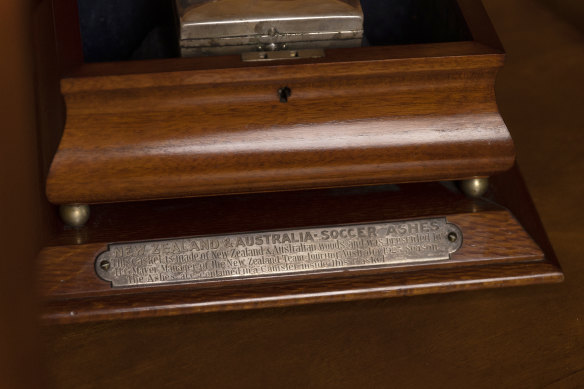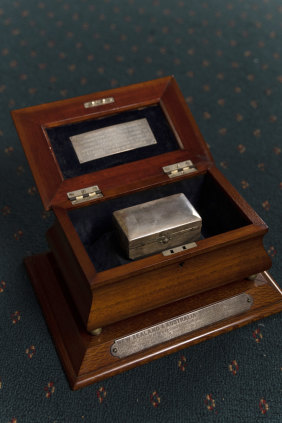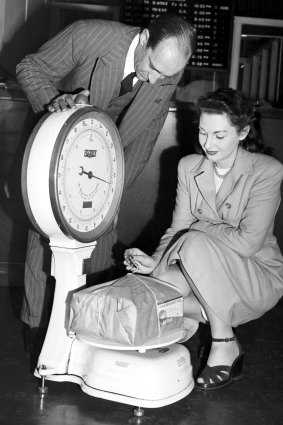This was published 2 years ago
‘Soccer’s Ashes’: How a suburban garage clean-out solved a 69-year Anzac mystery
By Vince Rugari
One of Australian soccer’s most enduring mysteries has been solved with the discovery of the long-lost “Soccer Ashes”, an ornate wooden trophy once contested regularly by the Socceroos and New Zealand’s All Whites until it disappeared without a trace 69 years ago.
After the first international series between the two nations on Australian soil in 1923, Socceroos captain Alex Gibb and his New Zealand counterpart George Campbell smoked two cigars - the ashes of which were kept in a silver-plated razor case carried at the Gallipoli landing by Private William Fisher, the secretary of the Queensland Football Association.
That razor case was housed within an elaborate wooden casket, made from New Zealand honeysuckle and Australian maple by New Zealand trophy maker Harry Mayer, and decorated with a kangaroo and a silver fern.
It was a nod to Test cricket’s Ashes - a term coined only 41 years earlier, and used broadly at the time to describe any sporting rivalry - and would become the symbol of trans-Tasman soccer supremacy.
That is, until 1954, when the trophy and any mention of it in historical records simply vanished into thin air.
The memory of it may also have been lost forever were it not for the efforts of historians Ian Syson and Trevor Thompson, who, with the assistance of Football Australia and some government funding, have spearheaded a recent push to find the missing Soccer Ashes - albeit with the fear, in the back of their minds, that they might have been mistakenly discarded as old rubbish.

The missing “Soccer Ashes” trophy has been found, 69 years after it was last seen or spoken about in historical archives.Credit: Football Australia
But earlier this year, the federation was contacted by the family of Sydney Storey - a former politician and Football Australia hall of fame member, who served as a key administrator in the sport between 1922 and his death in 1966, including a stint as chairman of the Australian Soccer Football Association - who found the missing Soccer Ashes in pristine condition.
They had been stowed away in his son’s garage, alongside other historical artefacts and pieces of sporting memorabilia, for more than 50 years, and were rediscovered when family members were cleaning it out because the house was being sold after his death - although it took another year for them to find the time to go through Storey’s soccer-related boxes properly, understand the significance of the trophy and notify Football Australia.

The prized trophy was sitting in a garage for half a century.Credit: Football Australia
“There was a lot of real history in my father’s garage... a whole heap of stuff, including big things and little things, boxes upon boxes,” said grandson James Storey, speaking on behalf of the family.
“We had to clear all of that, and we found these three boxes of historical soccer papers, photographs and these early annual reports of the soccer association. Among the trunks we found this well-preserved historical soccer trophy. It was quite extraordinary, with little engravings on it, a soccer ball motif on the top and a kangaroo - a really nice little item. We knew it was significant. But we didn’t know how significant.
“We looked with amazement at the history of the Ashes soccer game ... [it came with a] scrapbook an inch thick of an analysis, all the newspaper clippings of every game.
“This is not just a trophy, but it’s a symbol of Australia and New Zealand, working together, playing together, and looking after each other. It’s really, really powerful.”
The discovery comes a fraction too late for the Socceroos’ centenary, which was celebrated last year to mark 100 years since Australia’s first “A” international, against New Zealand in Dunedin in 1922, which the Storey family did not even know was being observed.
But it does give Football Australia the chance to use it, or a replica of it, once again as a trophy for any future internationals against New Zealand, or put it on public display if and when the federation can construct a planned national museum in Australia.

Australia’s Aaron Mooy looks to advance the ball in last year’s centenary match against New Zealand in Brisbane.Credit: Getty
It also mends a decades-old wound in the sport’s trans-Tasman history and adds further heft to the Anzac sporting legend.
Thompson, who authored the book Burning Ambition: The Centenary of Australia-New Zealand Football Ashes, had long theorised that Storey might have stowed away the trophy during a battle for the control between the old associations, which had run the sport in Australia for decades, and the newer federations and clubs which sprang up as a result of post-war ethnic migration. “My best guess, and it’s not a particularly strong guess, is in the 1950s in Australia, there was a huge political battle going on ... complete revolution in what the game looks like,” he said.

Back in the day: Soccer’s version of The Ashes are weighed in Sydney in 1948. The “Soccer Ashes” were contested by Australia and New Zealand between 1923 and 1954 - and only just rediscovered.
“I think that it’s possible that some of the association diehards, if you like, might have thought, ‘Okay, these guys are probably going to take over and there’s not much we can ultimately do to stop that. But they’re not having all of our stuff as well. This Ashes trophy, it’s got nothing to do with them. So why don’t we just take it away?’”
Thompson had tried to contact the Storey family about the Soccer Ashes around 20 years ago, having identified Sydney as a prime suspect due to his status as a leading administrator, but was rebuffed and told they wouldn’t speak to any outsiders.
“It’s quite possibly the greatest domestic treasure there is in the game,” he said.
Syson said it was a critical moment in Australian soccer - and, indeed, the sport’s perennial failure to remember its own history, and retain control of its own narrative.
“This trophy is symbolic of something really important, and its discovery is also really important as well,” Syson said.
“Its absence was a symptom of Australian soccer’s tendency to forget itself, and for the surrounding culture not to care at all. This trophy is replete with sacred significance to a country that is so obsessed with its Anzac mythology - for that to go missing, it says a lot about the way this game manages to shoot itself in the foot all the time.
“And so maybe this is a sign that the game can correct itself, can fix itself, can remember itself, if there’s enough people caring about it, if there’s enough people taking an interest in the history. It means so much for the game.”
Watch every match of the UEFA Champions League, UEFA Europa League and UEFA Europa Conference League on Stan Sport.